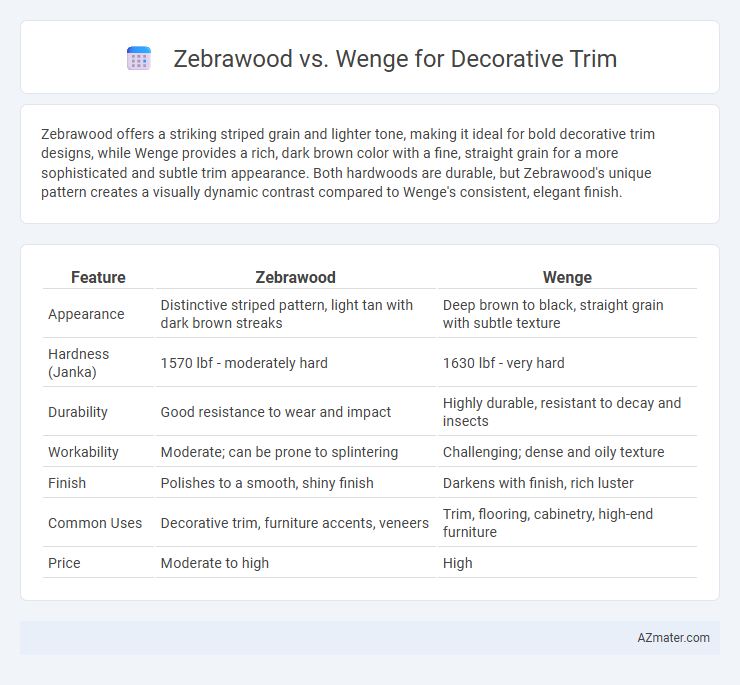Zebrawood offers a striking striped grain and lighter tone, making it ideal for bold decorative trim designs, while Wenge provides a rich, dark brown color with a fine, straight grain for a more sophisticated and subtle trim appearance. Both hardwoods are durable, but Zebrawood's unique pattern creates a visually dynamic contrast compared to Wenge's consistent, elegant finish.
Table of Comparison
| Feature | Zebrawood | Wenge |
|---|---|---|
| Appearance | Distinctive striped pattern, light tan with dark brown streaks | Deep brown to black, straight grain with subtle texture |
| Hardness (Janka) | 1570 lbf - moderately hard | 1630 lbf - very hard |
| Durability | Good resistance to wear and impact | Highly durable, resistant to decay and insects |
| Workability | Moderate; can be prone to splintering | Challenging; dense and oily texture |
| Finish | Polishes to a smooth, shiny finish | Darkens with finish, rich luster |
| Common Uses | Decorative trim, furniture accents, veneers | Trim, flooring, cabinetry, high-end furniture |
| Price | Moderate to high | High |
Introduction to Zebrawood and Wenge
Zebrawood, known for its striking light tan color with dark brown stripes, offers a bold, exotic appearance ideal for decorative trim, while Wenge features a deep, rich chocolate brown with subtle black streaks providing a sophisticated, modern look. Both hardwoods are prized for their durability and unique grain patterns, making them excellent choices for high-end interior accents. Zebrawood's coarse texture contrasts with Wenge's finer, smooth finish, influencing the tactile quality and aesthetic impact of decorative trim installations.
Origin and Botanical Overview
Zebrawood, primarily sourced from Microberlinia brazzavillensis trees native to Central Africa, features striking dark brown and cream stripes ideal for bold decorative trim contrasts. Wenge, derived from the Millettia laurentii tree endemic to the Congo Basin, displays deep, rich brown hues with fine black streaks, providing a sophisticated and dark aesthetic for interior accents. Both woods belong to the Fabaceae family, prized for their dense, durable hardwood qualities suitable for luxury trim installations.
Appearance and Grain Patterns
Zebrawood features bold, contrasting stripes with a light tan or creamy base and dark brown to black streaks, offering a striking and exotic appearance ideal for decorative trim. Wenge exhibits a deep, rich chocolate to black hue with fine, closely spaced grain lines that create a subtle yet elegant texture, perfect for a sophisticated and modern look. Both woods provide unique aesthetic qualities, with Zebrawood's dramatic pattern catching immediate attention while Wenge's uniform grain delivers a sleek, refined finish.
Color Variations and Visual Appeal
Zebrawood features striking dark brown stripes on a creamy to golden background, creating a bold, exotic appearance ideal for decorative trim that demands attention. Wenge displays a deep, rich chocolate brown with subtle black streaks, offering a more subdued yet sophisticated visual appeal perfect for elegant, modern interiors. The choice between Zebrawood's vibrant contrast and Wenge's dark, uniform tones depends on the desired aesthetic impact and color scheme of the trim application.
Durability and Hardness Comparison
Zebrawood exhibits a Janka hardness of approximately 1570, making it moderately hard and suitable for decorative trim that requires durability and resistance to denting. Wenge, with a higher Janka hardness rating around 1630, offers superior hardness and better wear resistance, making it ideal for high-traffic areas or trim subject to frequent contact. Both woods possess excellent durability, but Wenge's denser grain structure provides enhanced toughness against scratches and impact compared to Zebrawood.
Workability and Finishing Qualities
Zebrawood offers excellent workability with its straight to interlocked grain, allowing smooth cutting and shaping for decorative trim applications. Wenge, while harder and denser, requires sharper tools and more effort but provides a stunning deep brown finish with fine, consistent texture. Both woods take finishes well, though Zebrawood's lighter color highlights grain patterns, whereas Wenge's dark tone delivers a rich, elegant look ideal for high-end decorative trim.
Cost and Availability
Zebrawood and Wenge differ significantly in cost and availability for decorative trim projects. Zebrawood, sourced primarily from West Africa, tends to be more affordable and moderately available through specialty lumber suppliers. Wenge, native to Central Africa, is generally pricier due to its dense grain and limited supply, often requiring advance orders for larger quantities.
Environmental Impact and Sustainability
Zebrawood and Wenge both have distinct environmental impacts and sustainability profiles when used for decorative trim. Zebrawood, sourced primarily from West Africa, often faces challenges related to deforestation and illegal logging due to high demand. Wenge, native to Central Africa, is also vulnerable to overharvesting, but certification programs like FSC can help ensure more sustainable harvesting practices for both woods.
Best Applications for Decorative Trim
Zebrawood's bold, striped grain and light golden-brown color make it ideal for decorative trim in spaces seeking a striking, exotic appearance, such as luxury furniture and high-end cabinetry. Wenge, featuring a deep, dark brown hue with fine, linear grain patterns, excels in modern or minimalist interiors where a sophisticated, dramatic contrast is desired. Both woods offer durability and unique aesthetics, but Zebrawood suits lively, statement trims, whereas Wenge enhances sleek, elegant designs.
Choosing the Right Wood for Your Project
Zebrawood offers striking, contrasting grain patterns with a golden to light brown background ideal for bold decorative trim, while Wenge features deep, rich chocolate tones with tight, linear grain perfect for a more sophisticated, modern look. Consider Zebrawood for projects requiring a visually dynamic finish and Wenge for durable, elegant trims that resist wear. Selecting the right wood hinges on balancing aesthetic appeal, hardness (Zebrawood: Janka hardness ~1570; Wenge: ~1630), and project style to ensure long-lasting beauty.

Infographic: Zebrawood vs Wenge for Decorative Trim
 azmater.com
azmater.com